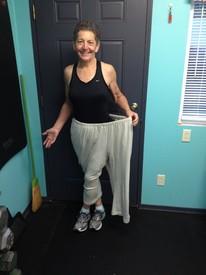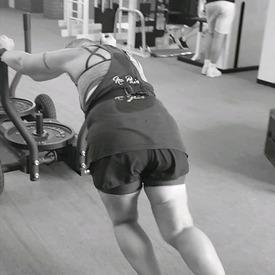Exercises for people with chronic pain and connective tissue disorders
Options

ajc109
Posts: 11 Member
I have hypermobile type Ehlers-Danlos Syndrome and can't do any kind of high impact exercises. I also can't do anything that involves being on my feet for more than 10 mins due to pain (swimming is not possible either as I don't drive or have the time).
Does anyone have an ideas of exercises I can do at home to aid my weight loss?
Does anyone have an ideas of exercises I can do at home to aid my weight loss?
0
Replies
-
I recently injured my knee and found a few exercises.. look up chair or couch exercises.. also I found the website Darebee.. it has so many exercises that you can change a little to make it something you can handle.. also if you look at the stuff for beginners it tends to have a lot of low impact stuff on there and different variations of other exercises...2
-
Stationery bike? Or resistance bands?1
-
Is there any chance you can see a specialist? A physiotherapist or occupational therapist would have a much better idea of what would be suitable.5
-
glovepuppet wrote: »Stationery bike?
That's a great suggestion!! Was trying to think of something and biking never entered my mind. Actually - you can get a real bike and bike outside!!! "I want to ride my bicycle. I want to ride my bike. I want to ride my bicycle. I want to ride it where I like." Now there's an oldie but goodie!!!
0 -
Even safer than a stationary bike, if you have any issues with your hips, you can get armchair cycles. Just the pedals, which you put in front of a chair.
1 -
I have a stationary bike desk at home, so I ride it slowly while doing work I don't need full concentration for.
Yoga and pilates can be hit or miss with EDS. I have mild hypermobility and a lot of the symptoms but no formal diagnosis. I used to sprain/sublux my ankles a lot. Balancing exercises helped me strengthen the muscles around the joints, which was good. So I personally find them useful, but you might want to double check with a specialist if it's the right approach for you.
Otherwise, short 10 minute walks, fidgeting a bit more in your day to day life? Resistance bands or light weights/a kettlebell?
But in the end if the exercise is hurting, you don't *need* it for weight loss. Just a calorie deficit will do it.1 -
Not sure if this is anything you didn't know already...
https://patientworthy.com/2017/11/21/dos-donts-exercising-with-ehlers-danlos-syndrome/0 -
There are seated exercises o you tube and a show on PBS called Sit and Be Fit.
Has anyone mentioned a rower?
Lots of upper body exercises with weights can be done seated. You could alternate 5-10 min standing exercises with 5-10 min seated upper body a few times and get a great full body low impact workout.0 -
https://www.ehlers-danlos.org/information/exercise-and-movement-for-adults-with-hypermobile-ehlers-danlos-syndrome-and-hypermobility-spectrum-disorders/
They suggest the armchair cycles and resistance bands, and have more in depth advice.1 -
My physiatrist sent me tp physical therapy for functional restoration, and they gave me resistance bands and strength work to do at home. The exercises are intended to improve my quality of life, but I also look nicer with more muscle.0
-
Though it doesn't assist with weight loss directly, I highly recommend resistance training to help retain muscle.
Resistance training has many other benefits as well including reducing pain for those who deal with chronic pain and improving quality of life. Adherence rates are high and comparable to aerobic exercise.
I've found personally and for those who I train who also deal with pain and connective tissues issues that barbell training with proper load management is the most useful resistance training.
0 -
I have hypermobile type Ehlers-Danlos Syndrome and can't do any kind of high impact exercises. I also can't do anything that involves being on my feet for more than 10 mins due to pain (swimming is not possible either as I don't drive or have the time).
Does anyone have an ideas of exercises I can do at home to aid my weight loss?
Right I have eds type 3 and there's a lot of Can'ts there that eventually you can turn to cans.
When I started out I was on tramadol 3x daily, used crutches to walk across a room and couldn't get myself off the floor. Now I occasionally take a low dose of codeine and I run marathons. Yes I do still live with a background level of pain, but I don't let it stop me.
Strength training is possibly the most important thing you can do, not machines but free weights, so that's a barbell or dumbells. This will help strengthen all those little stabilising muscles that will then reduce the risk of dislocations and sublexations. Believe me, I used to sublex in my ankles at least once a month, haven't done it for over a year.
At the same time you'll want to try and get some cardio in. Start with walking, we do tire easier so build it up slowly. Try to keep to even ground until your stabilisers strengthen. Even now I really feel it in my ankles when I run trail, because they are working so much harder. The elliptical can be good, but I find there are some that I can't use because the range of motion is wrong. Rowing machines have been one of my cardio mainstays since day one, just make sure you get your technique right.
I also enjoying PiYo (inspired by pilates and yoga but from Insanity), it's giving me the confidence in my body to allow it to stretch further and further without worrying about dislocations.
The most important thing is to listen to your body. As I said you will probably tire quicker than a non bendy, you will need to take care when stretching (one of the stretches we do in class for biceps is actually totally ineffective for me as it involves pushing the hand back in a range of motion that doesn't actually stretch for me so I have to do something else). If you go to any classes tell the instructor that you are hypermobile. If you have a physio ask them for advice (mine is very happy with my progress and their main advice is that if it's a new pain that lasts for more than a couple seconds then stop). If you can afford it book a few sessions with a personal trainer that understands the condition.6 -
I do not have EDS, but I do have hyper mobility issues and many similar issues with chronic pain, easily injured joints, etc. I have fallen in love with Barre classes. Similar to Piyo, its low to no impact, strengthens the core, and uses body weight and/or light free weights to build strength. It is really the only thing that I have been able to do that gives me cardio without injury. And I could tell after only a couple of weeks that I was getting stronger.0
-
glovepuppet wrote: »Is there any chance you can see a specialist? A physiotherapist or occupational therapist would have a much better idea of what would be suitable.
Yes, getting a referral to a specialist is my recommendation as well.0
This discussion has been closed.
Categories
- All Categories
- 1.4M Health, Wellness and Goals
- 396.5K Introduce Yourself
- 44.2K Getting Started
- 260.8K Health and Weight Loss
- 176.3K Food and Nutrition
- 47.6K Recipes
- 232.8K Fitness and Exercise
- 449 Sleep, Mindfulness and Overall Wellness
- 6.5K Goal: Maintaining Weight
- 8.7K Goal: Gaining Weight and Body Building
- 153.3K Motivation and Support
- 8.3K Challenges
- 1.3K Debate Club
- 96.5K Chit-Chat
- 2.6K Fun and Games
- 4.5K MyFitnessPal Information
- 16 News and Announcements
- 18 MyFitnessPal Academy
- 1.4K Feature Suggestions and Ideas
- 3K MyFitnessPal Tech Support Questions









